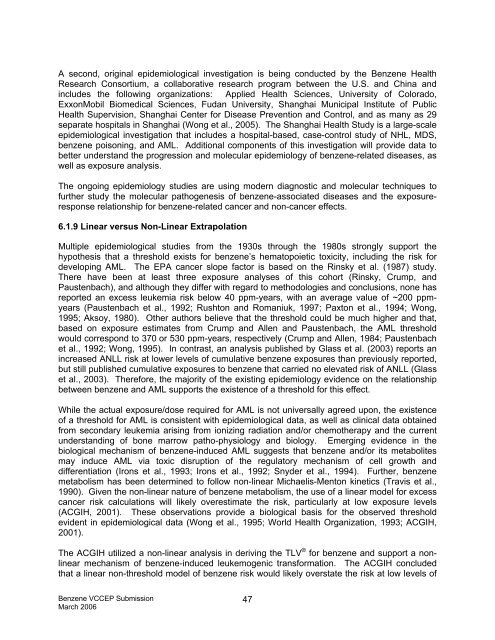(VCCEP) Tier 1 Pilot Submission for BENZENE - Tera
(VCCEP) Tier 1 Pilot Submission for BENZENE - Tera
(VCCEP) Tier 1 Pilot Submission for BENZENE - Tera
Create successful ePaper yourself
Turn your PDF publications into a flip-book with our unique Google optimized e-Paper software.
A second, original epidemiological investigation is being conducted by the Benzene Health<br />
Research Consortium, a collaborative research program between the U.S. and China and<br />
includes the following organizations: Applied Health Sciences, University of Colorado,<br />
ExxonMobil Biomedical Sciences, Fudan University, Shanghai Municipal Institute of Public<br />
Health Supervision, Shanghai Center <strong>for</strong> Disease Prevention and Control, and as many as 29<br />
separate hospitals in Shanghai (Wong et al., 2005). The Shanghai Health Study is a large-scale<br />
epidemiological investigation that includes a hospital-based, case-control study of NHL, MDS,<br />
benzene poisoning, and AML. Additional components of this investigation will provide data to<br />
better understand the progression and molecular epidemiology of benzene-related diseases, as<br />
well as exposure analysis.<br />
The ongoing epidemiology studies are using modern diagnostic and molecular techniques to<br />
further study the molecular pathogenesis of benzene-associated diseases and the exposureresponse<br />
relationship <strong>for</strong> benzene-related cancer and non-cancer effects.<br />
6.1.9 Linear versus Non-Linear Extrapolation<br />
Multiple epidemiological studies from the 1930s through the 1980s strongly support the<br />
hypothesis that a threshold exists <strong>for</strong> benzene’s hematopoietic toxicity, including the risk <strong>for</strong><br />
developing AML. The EPA cancer slope factor is based on the Rinsky et al. (1987) study.<br />
There have been at least three exposure analyses of this cohort (Rinsky, Crump, and<br />
Paustenbach), and although they differ with regard to methodologies and conclusions, none has<br />
reported an excess leukemia risk below 40 ppm-years, with an average value of ~200 ppmyears<br />
(Paustenbach et al., 1992; Rushton and Romaniuk, 1997; Paxton et al., 1994; Wong,<br />
1995; Aksoy, 1980). Other authors believe that the threshold could be much higher and that,<br />
based on exposure estimates from Crump and Allen and Paustenbach, the AML threshold<br />
would correspond to 370 or 530 ppm-years, respectively (Crump and Allen, 1984; Paustenbach<br />
et al., 1992; Wong, 1995). In contrast, an analysis published by Glass et al. (2003) reports an<br />
increased ANLL risk at lower levels of cumulative benzene exposures than previously reported,<br />
but still published cumulative exposures to benzene that carried no elevated risk of ANLL (Glass<br />
et al., 2003). There<strong>for</strong>e, the majority of the existing epidemiology evidence on the relationship<br />
between benzene and AML supports the existence of a threshold <strong>for</strong> this effect.<br />
While the actual exposure/dose required <strong>for</strong> AML is not universally agreed upon, the existence<br />
of a threshold <strong>for</strong> AML is consistent with epidemiological data, as well as clinical data obtained<br />
from secondary leukemia arising from ionizing radiation and/or chemotherapy and the current<br />
understanding of bone marrow patho-physiology and biology. Emerging evidence in the<br />
biological mechanism of benzene-induced AML suggests that benzene and/or its metabolites<br />
may induce AML via toxic disruption of the regulatory mechanism of cell growth and<br />
differentiation (Irons et al., 1993; Irons et al., 1992; Snyder et al., 1994). Further, benzene<br />
metabolism has been determined to follow non-linear Michaelis-Menton kinetics (Travis et al.,<br />
1990). Given the non-linear nature of benzene metabolism, the use of a linear model <strong>for</strong> excess<br />
cancer risk calculations will likely overestimate the risk, particularly at low exposure levels<br />
(ACGIH, 2001). These observations provide a biological basis <strong>for</strong> the observed threshold<br />
evident in epidemiological data (Wong et al., 1995; World Health Organization, 1993; ACGIH,<br />
2001).<br />
The ACGIH utilized a non-linear analysis in deriving the TLV ® <strong>for</strong> benzene and support a nonlinear<br />
mechanism of benzene-induced leukemogenic trans<strong>for</strong>mation. The ACGIH concluded<br />
that a linear non-threshold model of benzene risk would likely overstate the risk at low levels of<br />
Benzene <strong>VCCEP</strong> <strong>Submission</strong><br />
March 2006<br />
47





